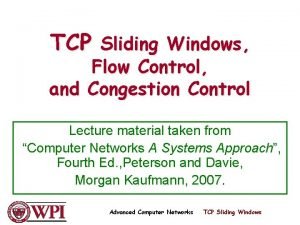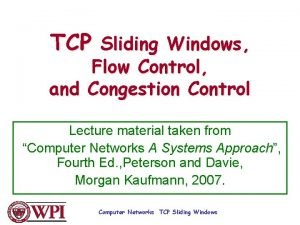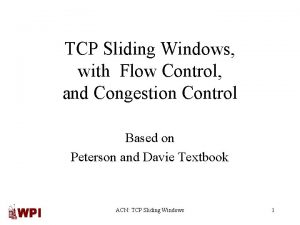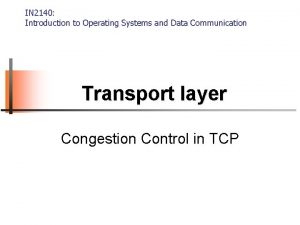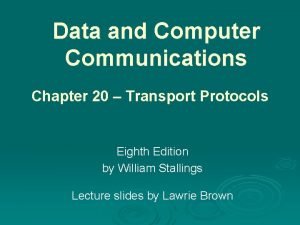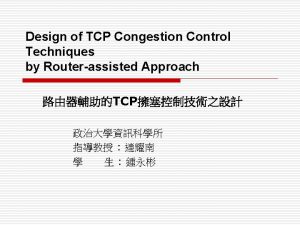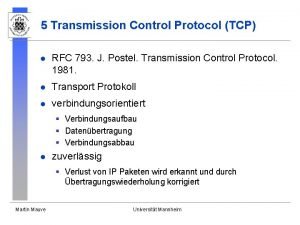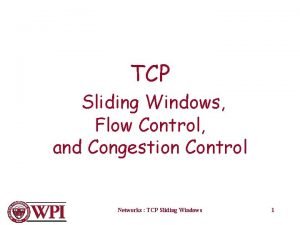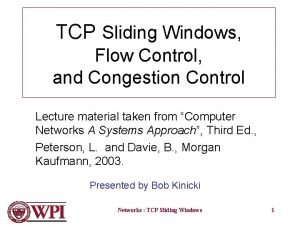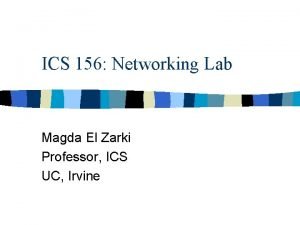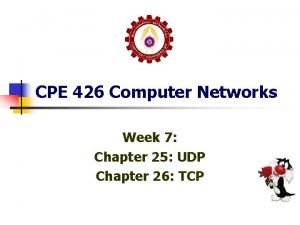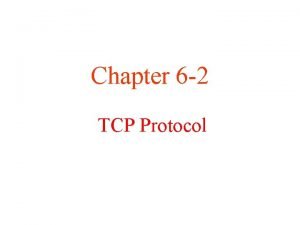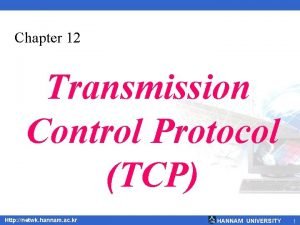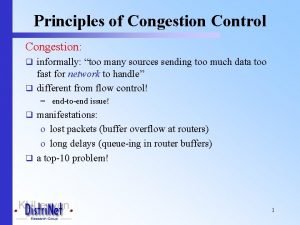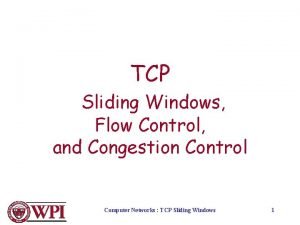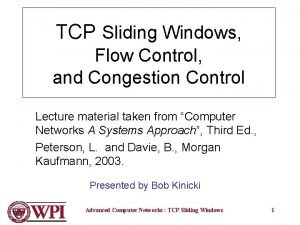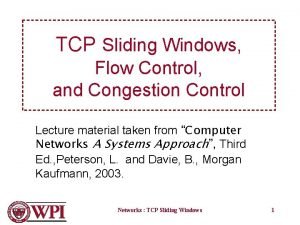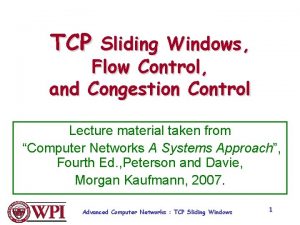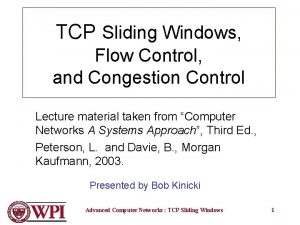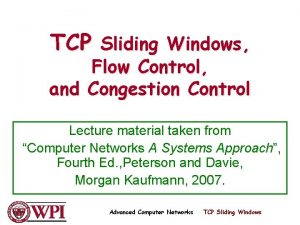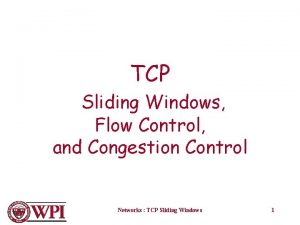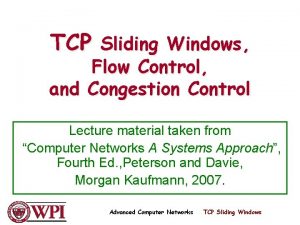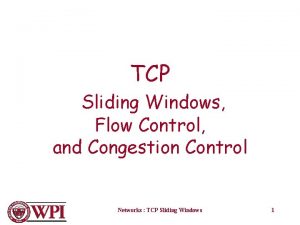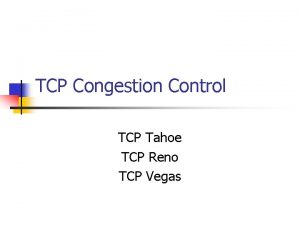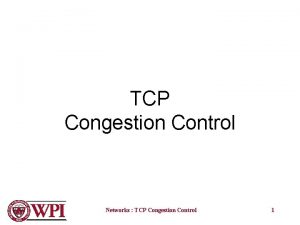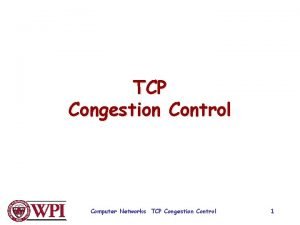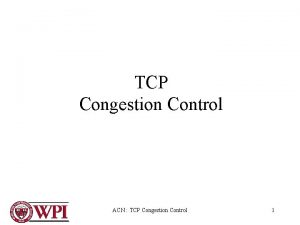TCP Sliding Windows Flow Control and Congestion Control



















- Slides: 19

TCP Sliding Windows, Flow Control, and Congestion Control Based on Peterson and Davie Textbook ACN: TCP Sliding Windows 1

Sliding Windows • Normally a data link layer concept • Interest is understanding TCP mechanism at the transport layer. • Each frame is assigned a sequence number Seq. Num • The sender maintains three variables: send window size (SWS), last ACK received (LAR), and last Frame sent (LFS) ACN: TCP Sliding Windows 2

Sender Variables • SWS : : the upper bound on the number of outstanding frames (not ACKed) the sender can transmit • LAR : : the sequence number of the last ACK received • LFS : : the sequence number of the last frame sent ACN: TCP Sliding Windows 3

Sender Invariant LFS – LAR <= SWS <=SWS LAR LFS ACN: TCP Sliding Windows 4

Sender Window • An arriving ACK LAR moves right 1 sender can send one more frame • Associate a timer with each frame the sender transmits • Sender retransmits the frame if the timer times out • Sender buffer : : up to SWS frames ACN: TCP Sliding Windows 5

Receiver variables • Receiver window size (RWS) : : the upper bound on the number of out-of-order frames the receiver is willing to accept • Largest acceptable frame (LAF) : : the sequence number of the largest acceptable frame • Last frame received (LFR) : : the sequence number of the last frame received ACN: TCP Sliding Windows 6

Receiver Invariant LAF – LFR <= RWS <=RWS LFR LAF ACN: TCP Sliding Windows 7

Receiver Window When a frame arrives with Seq. Num: If (Seq. Num <= LFR or Seq. Num > LAF) the frame is discarded because it is outside the window. If (LFR < Seq. Num <= LAF) the frame is accepted. ACN: TCP Sliding Windows 8

Receiver ACK Decisions Seq. Num. To. Ack : : largest sequence number not yet ACKed such that all frames <= Seq. Num. To. Ack have been received. • Receiver ACKs receipt of Seq. Num. To. Ack and sets LFR = Seq. Num. To. Ack LAF = LFR + RWS Seq. Num. To. Ack is adjusted appropriately! ACN: TCP Sliding Windows 9

TCP Sliding Windows * • • • switch from packet pointers to byte pointers Guarantees reliable delivery of data. Ensures data delivered in order. Enforces flow control between sender and receiver. • The idea is: the sender does not overrun the receiver’s buffer. ACN: TCP Sliding Windows 10

ACN: TCP Sliding Windows 11

Receiver’s Advertised Window • The big difference is that the size of the sliding window size at the receiver is not fixed. • The receiver advertises an adjustable window size (Advertised. Window field in TCP header). • Sender is limited to having no more than Advertised. Window bytes of un. ACKed data at any time. ACN: TCP Sliding Windows 12

TCP Flow Control • The discussion is similar to the previous sliding window mechanism except we add the complexity of sending and receiving application processes that are filling and emptying their local buffers. • Also we introduce the complexity that buffers are of finite size without worrying about where the buffers are stored. Max. Send. Buffer Max. Rcv. Buffer ACN: TCP Sliding Windows 13

TCP Flow Control • Receiver throttles sender by advertising a window size no larger than the amount it can buffer. On TCP receiver side: Last. Byte. Rcvd - Last. Byte. Read <= Max. Rcv. Buffer to avoid buffer overflow! ACN: TCP Sliding Windows 14

TCP Flow Control TCP receiver advertises: Advertised. Window = Max. Rcv. Buffer (Last. Byte. Rcvd - Last. Byte. Read) i. e. , the amount of free space available in the receiver’s buffer. ACN: TCP Sliding Windows 15

TCP Flow Control The TCP sender must adhere to Advertised. Window from the receiver such that Last. Byte. Sent – Last. Byte. Acked <= Advertised. Window or use Effective. Window: Effective. Window = Advertised. Window – (Last. Byte. Sent – Last. Byte. Acked) ACN: TCP Sliding Windows 16

TCP Flow Control Sender Flow Control Rules: 1. Effective. Window > 0 for sender to send more data 2. Last. Byte. Written – Last. Byte. Acked <= Max. Send. Buffer equality send buffer is full!! TCP sender process must block the sender application. ACN: TCP Sliding Windows 17

TCP Congestion Control • Congestion. Window : : a variable held by source for each connection. * TCP is modified such that the maximum number of bytes of unacknowledged data allowed is the minimum of Congestion. Window and Advertised. Window. Max. Window : : min (Congestion. Window , Advertised. Window ) ACN: TCP Sliding Windows 18

TCP Congestion Control And finally, we have: Effective. Window = Max. Window – (Last. Byte. Sent – Last. Byte. Acked) The idea : : the source’s effective window can be no faster than the slowest of the network (i. e. , its core routers) or the destination Host. * The TCP source receives implicit and/or explicit indications of congestion by which to reduce the size of Congestion. Window. ACN: TCP Sliding Windows 19
 Tcp flow control sliding window
Tcp flow control sliding window Sliding window flow control mechanism
Sliding window flow control mechanism Tcp sliding window
Tcp sliding window Pincuegula
Pincuegula In2140
In2140 Tcp congestion control
Tcp congestion control Principles of congestion control
Principles of congestion control Tcp segment header
Tcp segment header Flow control
Flow control Rfc 793
Rfc 793 Tcp sliding window mechanism
Tcp sliding window mechanism Tcp sliding window
Tcp sliding window Magda el zarki
Magda el zarki Tcp flow control
Tcp flow control Tcp flow control
Tcp flow control Tcp flow control
Tcp flow control Tcp flow control diagram
Tcp flow control diagram General principles of congestion control
General principles of congestion control Network provisioning in congestion control
Network provisioning in congestion control Principles of congestion control
Principles of congestion control
